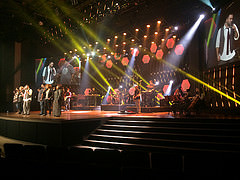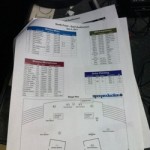
A Long December – Week 3: Big Finale
40 musicians on our stages. That was the name of the game for week 3 of our December music as we wrapped things up with a Gospel/R&B/Neo-Soul inspired set of music featuring 20 people on each of our two stages.
This was the week I knew would push our limits because, quite frankly, we were not equipped to handle it when the idea was initially presented. The instrumentation for this week consisted of: drums, bass, a percussion setup, two keyboard players, an electric guitar, 4 horns, 3 strings, 2 lead vocals, 5 background vocals, and, of course, a few backing tracks.
From the input side, this was probably one of the first weeks since our last Drive Conference where we filled a lot of them, but there was still a bit of margin which is always nice to have. The real challenge, however, was on the monitor side.
VENUE will only do 24 outputs which breaks down to 12 stereo mixes. So the decision was made to put most of the vocals on mono mixes since this would increase our monitor mix output capacity. Most players I know would rather have their own mono in-ears mix than share a stereo one. Plus we knew a lot of the singers would happily pull an ear anyway reducing their mix to mono. I still discourage this behavior because it’s pretty dangerous in the long run for your hearing, but this week it definitely helped us on the production side. The rest of the main rhythm section of the band got stereo mixes with the string players on mono mixes and the horns sharing a wedge mix. This was one of the many things I’m thankful our other audio staffers helped figure out for approaching these bands.
As for microphones, the drums and guitar got my standard setup I’ve been using for quite a while now; you can probably search the blog and find it in a “Sate of the Mix” article somewhere. The percussion setup got a couple Shure KSM32’s for overheads with a couple of Shure Beta98’s on the two conga’s. The horns were mic’ed with Shure Beta98’s. The cello got a DPA 4099, and the violin and viola got a couple of our DPA 4061’s. The horn, perc, and string mics were assembled from several of our campuses and traveled with the band along with a pair of Meyer Sound UPJ’s as wedges for the horn section.
This week wasn’t so much hard as it was just a lot of work to make happen. Coming off of the electronic bands last week and moving back to acoustic instruments meant completely rewiring two full stages. We also put the drums on a taller riser than usual which required some creativity in using our drop-snakes since the normal ones are for all intents and purposes somewhat permanently mounted now on our new risers we started using a couple weeks ago. Fortunately when we put the new snakes in four years ago I had the foresight to make sure they could reach to opposite ends of the stage where we ended up pulling some of them this week to make it all happen.
It had been so long since I’ve had to pin two complete stages from scratch, I’d forgotten how much work it can be. Our drums alone are at 15 inputs plus another 8 for tracks coming from a computer on the drum riser. Then there’s our normal guitar and keys stuff followed by the additional horns and strings this week. Then there were some hardwired mics for all of the background vocals in one of our auditoriums because we don’t have enough RF handhelds to accommodate all the vocalists spread across both stages this week. Add to that the wedges on both sides along with extra hardwired packs. Then there was a lot of reprogramming of RF IEM packs to run in mono. It just all adds up, and by the time I was finished with everything including checking console programming and finishing up programming my FOH desk I had band members starting to show up for rehearsal. All in all, by my estimation getting everything set on two stages for 40 musicians took me a little over two full days worth of work, and that was with some help from a couple of our other production guys.
Once the setup was done, though, it was really just another day at the office, although, there were some different aesthetics to keep in mind. I’d been listening to a fair amount of R&B/Neo-Soul stuff since the summer when Jared in our music department started casting vision for this week trying to get my head around some of the things that make this style of music tick. One changeup from my usual approach was to go drier on most of the instrumentation and vocals. Reverbs were usually pretty short and theoretically transparent this week, and I think I only used one delay.
Something that got a bit more use this week was the Waves PS22 plugin. This has turned out to be the plugin of the month for me. One key place I ended up using this was on all the background vocals. One of the things that stuck out to me getting ready for the week was how wide the panning often is on background vocals for modern R&B. This just stuck out to me as part of the aesthetic of the genre so I wanted to try and capture some of this if I could. Of course, I can’t hard pan vocals in my room because that’s just not gonna work for live sound so I gave the PS22 a try. I wasn’t sure how I’d like it on vocals, but it really helped get them feeling wider and bigger in the room while preserving the musical content throughout the room. The backgrounds also got some split-harmonizer added along with one of my other new favorites, the Waves Reel ADT. All input processing for the backgrounds was handled by a Renaissance Channel.
I routed the horns to their own group where I treated them with another Waves PS22. Slapping a Renaissance Axe plugin across the group also made me happy so thanks to Andy Meyer for the idea. The horns got a little bit of reverb added courtesy of TrueVerb and finally a C6 across the group helped keep the upper-mids under control.
The strings were a combination of tracks and a bit of the live mics. The tracks we used were actually recorded during rehearsals so they were tracks of the actual players on the stage using the same mics just without all the drum kit and PA bleed. I routed all of these to a group where I did a little overall compression with a Waves CLA2A and a C4 multi-band for overall frequency smoothing. One nice trick I got from my friend, Chris Briley, was to gate the live string mics and key them off the string tracks which helped keep the mix tighter and cleaner when the strings weren’t playing. Parenthetically, this trick works nicely on choir mics, too, boys and girls.
In terms of the overall mix itself, I tried to approach it from a different angle than our normal band since stylistically this wasn’t supposed to be the rock show. I pushed the vocals a little more out front this week and pulled the drums back a bit. I also tried to stay away from the big, fat rock snare as much as possible; Tim Corder recommended manipulating the transient on it a bit so I employed the SPL Transient Designer plugin for the first time in quite a while to help with that. The keyboards ended up getting featured more, and I didn’t dial in the guitar to cut quite the same way as I usually do which I think in hindsight actually bit me on at least one of the songs where I missed some nice guitar stuff that could have been featured more. Outside of that it was just a lot of fader riding to feature different stuff at different times.
So this brings up a great opportunity to do a little demonstration. I think Tim Corder’s online mix of our opener was a good example of why I like that we do a separate broadcast mix. So here’s Tim’s mix.
121414 Christmas Jazz Opener from North Point Online on Vimeo.
Now here’s an embedded version of my FOH mix that starts about 2:27 into the video above.
[audio:everybody.mp3]Personally, I’m fairly happy with the way my FOH mix came out, although, I think it felt a lot better in the room as it should have. Something to note in the FOH mix, though, are the exaggerated pushes compared to the online mix. For example, check out the lead guitar lick in the first verse, and how it’s overcooked. Some of the horn stabs and string lines get similar pushes through the course of the song. I think Tim’s mix, on the other hand, feels much better listening at home. I wish I had gotten that bass tone he had, but since I relied more on the subs for it this week it doesn’t quite translate the same outside the room. Ultimately, though, I think these mixes both also illustrate a great point: there is no ONE perfect mix.
This was the final week in our December mini-tour, and I think it was a good note to end on. Our Christmas services were sort of business as usual with added Christmas songs. I’ve enjoyed relaxing over the last week or so from the month of December, but now I’m looking forward to getting back to work in 2015.


 Next Post
Next Post



Great post, loved hearing the differences between the broadcast and live mixes. The biggest thing I noted was how “gelled” your backing vocals were in both mixes. Care to talk about any group processing or approaches to that? Obviously they performed well together and that’s the biggest part, but any tips from our end of the console?
Well, one thing to keep in mind is that this was the third week those singers had been doing these songs so they were well rehearsed. So that was at least 3 services each week along with probably another 3-4 run throughs each week on top of the initial rehearsing they did. So that’s probably the biggest part of it.
I can’t speak for broadcast, but I had some compression on each singer probably with Waves Ren Channel. Then all the BV’s were sent to a group where they got a very very light touch of group compression.